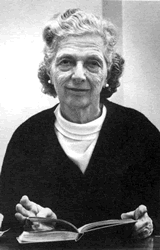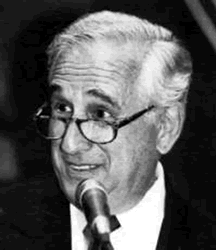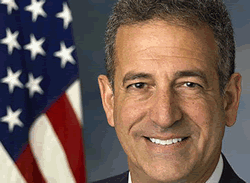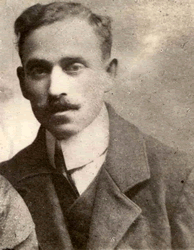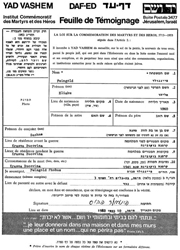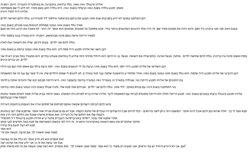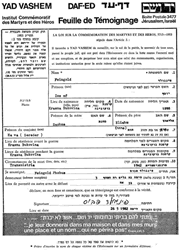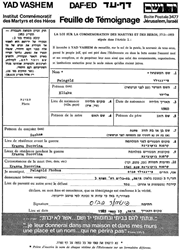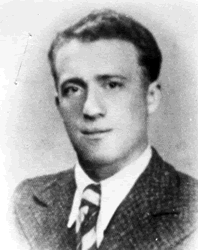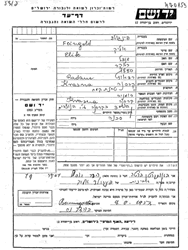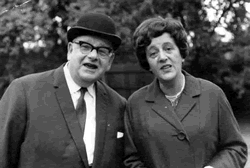Feingold Family
Click on Photos to Enlarge
#fgld-1:
#fgld-2:
#fgld-3:
#fgld-4:
#fgld-5:
#fgld-6:
#fgld-7:
#fgld-8
#fgld-9
#fgld-10
#fgld-11
Jessica Feingold devoted more than forty-five years of her life to carrying out the goals of the Jewish Theological Seminary. She edited fifty books that originated at the institution, while also serving in almost uncountable administrative positions, including that of principal assistant to Louis Finkelstein, who was provost, president, and then chancellor of the seminary.
Dr. Henry L. Feingold is one of America’s distinguished scholars on the American Holocaust witness role and the reaction of the American Jewry to the Holocaust. In this area, his most important works are The Politics of Rescue: The Roosevelt Administration and the Holocaust, 1938-1945(1971) and, more recently, Bearing Witness, How America and Its Jews Responded to the Holocaust (1995). Dr. Feingold is also recognized as one of the foremost students of American Jewry. His works include Zion in America: The Jewish Experience from Colonial Times to the Present (1974);A Midrash on the History of American Jewry (1982); A Time for Searching: Entering the Mainstream, 1920-1945 (1992); and Lest Memory Cease, Finding Meaning in the American Jewish Past (1996). He is also the General Editor of the five volume series published by Johns Hopkins University, The Jewish People in America (1992).
Dr. Feingold has served in offices in numerous organizations including the American Jewish Historical Society, The American Jewish Congress, The United States Holocaust Memorial Council, and The Museum of Jewish Heritage. He is currently Director of the Jewish Resource Center at Baruch College and Professor of History at Baruch College and The Graduate Center, CUNY. He received his Ph.D from New York University.
Dr. Feingold is available to lecture on American Jewry and the Holocaust: Was there communal failure?; the Holocaust in historical perspective; have we reached the saturation point in Holocaust memorials?; European Jewry (1938-1945), Soviet Jewry (1967-1989): a study in contrast; the Resistance Mystique; and finding meaning for the Holocaust. He lives in New York City.
- See more at: http://www.jfr.org/pages/education/for-teachers/speakers-bureau/henry-feingold#sthash.nO018xjW.dpuf
Russ Feingold named State Department’s Africa envoy
Former Wisconsin senator will oversee foreign policy on war-torn region that includes Congo, Rwanda, and Burundi
June 19, 2013, 11:37 pm 4
Read more: Russ Feingold named State Department's Africa envoy | The Times of Israel http://www.timesofisrael.com/russ-feingold-named-state-departments-africa-envoy/#ixzz2s8aXB5fO
Follow us: @timesofisrael on Twitter | timesofisrael on Facebook
Some Feingold family members who perished;
-- Meir Feingold was born in Krasna, Romania in 1890 to Eliahu. Prior to WWII he lived in Krasna, Romania. During the war he was in Krasna, Romania. Meir was murdered/perished in 1942 in the Shoah. This information is based on a Page of Testimony submitted by his son.
Phobus Feingold Of Haifa
on left) submitted by his nephew
Eliahu Feingold was born in 1860. He was married to Sachne. Prior to WWII he lived in Krasna, Romania. During the war he was in Krasna, Romania. Eliahu was murdered/perished in 1941 in Krasna, Romania. This information is based on a Page of Testimony (displayed on left) submitted by his grandson.
Sachne Feingold was born in 1862. She was married to Eliahu. Prior to WWII she lived in Krasna, Romania. During the war she was in Krasna, Romania. Sachne was murdered/perished in 1941 in Krasna, Romania. This information is based on a Page of Testimony (displayed on left) submitted by her grandson.
Yosef Feingold was born in Krasna, Romania in 1898. He was married to Hava nee Sereder. Prior to WWII he lived in Krasna, Romania. During the war he was in Krasna, Romania. Yosef was murdered/perished in 1942 in Transnistria, Ukraine (USSR). This information is based on a Page of Testimony (displayed on left) submitted by his nephew
Hava Feingold nee Sereder was born in Arbore, Romania in 1900. Prior to WWII she lived in Krasna, Romania. During the war she was in Krasna, Romania. Hava was murdered/perished in 1942 in the Shoah. This information is based on a Page of Testimony (displayed on left) submitted by her
Wili Feingold was born in Krasna, Romania in 1925 to Khava. Prior to WWII he lived in Krasna, Romania. During the war he was in Krasna, Romania. Wili was murdered/perished in 1942 in Transnistria, Ukraine (USSR). This information is based on a Page of Testimony (displayed on left) submitted by his cousin
Dov Feingold was born in Radovits, Romania. He was a tailor and married to Seva nee Shpigler. Prior to WWII he lived in Radovits, Romania. During the war he was in Czernowitz, Romania. Dov was murdered/perished in 1941 in Ustia, Romania at the age of 52. This information is based on a Page of Testimony (displayed on left) submitted by his son
Yakov Feingold was born in Radauc, Romania to Dov. Prior to WWII he lived in Radauc, Romania. During the war he was in Czernowiec, Romania. Iakov was murdered/perished in the Shoah at the age of 22. This information is based on a Page of Testimony (displayed on left) submitted by his brother Yosef.
Alik Feingold was born in Radauc, Romania in 1880 to Mendel and Rivka. He was married to Sakhna. Prior to WWII he lived in Krasna, Romania. During the war he was in Krasna, Romania. Alik was murdered/perished in Krasna, Romania. This information is based on a Page of Testimony (displayed on left) submitted by his niece.
brother of Eliyahu; Icchak Feingold was born in Szpakow, Poland in 1882 to Mendel and Rivka. He was married to Sara. Prior to WWII he lived in Seletin, Romania. During the war he was in Seletin, Romania. Icchak was murdered/perished in the Shoah. This information is based on a Page of Testimony (displayed on left) submitted by his niece.
picture of his wife Sarah who perished;
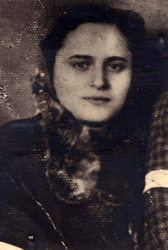
Sara Feingold was born in Seletin, Romania in 1884. She was married to Yitzkhak. Prior to WWII she lived in Seletin, Romania. During the war she was in Seletin, Romania. Sara was murdered/perished in the Shoah. This information is based on a Page of Testimony (displayed on left) submitted by her niece.
Rachel Feingold was born in Seletin, Romania in 1902 to Yitzkhak and Sara. She was married to Herman( he also perished) and had a daughter Gitel perished at age 10. Prior to WWII she lived in Seletin, Romania. During the war she was in Seletin, Romania. Rachel was murdered/perished in Transnistria, Ukraine (USSR). This information is based on a Page of Testimony (displayed on left) submitted by her relative.
Nephew of Eliyahu; Berl Feingold was born in Radauc, Romania in 1888 to Yaakov (brother of Eliyahu who died before 1920) and Gitel (perished in the holocaust). He was a tailor and married to Sheva. Prior to WWII he lived in Radauc, Romania. During the war he was in Radauc, Romania. Berl was murdered/perished in the Shoah. This information is based on a Page of Testimony (displayed on left) submitted by his sister Berta.
Others who left Europe;
Jessica Feingold devoted more than forty-five years of her life to carrying out the goals of the Jewish Theological Seminary. She edited fifty books that originated at the institution, while also serving in almost uncountable administrative positions, including that of principal assistant to Louis Finkelstein, who was provost, president, and then chancellor of the seminary.
Photographer: John H. Popper; Institution: The Ratner Center for the Study of Conservative Judaism, Jewish Theological Seminary
by Julie Miller
Jessica Feingold was the director of Intergroup Activities at the Jewish Theological Seminary 0f America from 1959 to 1983 and served in administrative capacities in the seminary’s two principal “intergroup relations” programs, the Conference on Science, Philosophy, and Religion and the Institute for Religious and Social Studies.
She was born on December 28, 1910, in New Orleans, Louisiana, the first of three children and only daughter of Jessie (Schwabacher) and Meyer William Feingold. Her mother was born in Chicago of a well-to-do German Jewish family. Her father was born in Romania, immigrated to the United States with his family, and grew up in New Orleans where he studied at Tulane University.
During Jessica Feingold’s childhood in New Orleans, her father was a partner in Levy, Loeb and Company, a dry-goods business. In 1917, William Feingold accepted a position as an executive at J. Aron and Company on Wall Street, and the family moved to New York City.
Although she had gone to public school in New Orleans, Feingold and her two brothers went to private schools in New York. Jessica Feingold graduated from the Calhoun School in 1927 (originally the Jacobi School), an academically rigorous girls’ school attended by daughters of German Jewish families. She also attended the Hebrew school at Temple Emanu-El, but found little there to interest her. Although the Feingolds were nominally Reform, religion played only a small part in their family life.
After Calhoun, Feingold attended Vassar College, where she experienced the social discomfort of being one among very few Jews. She graduated from Vassar in 1931, then attended Columbia University, where she received an M.A. in history in 1933. Uncertain of her vocation in a period when few professional opportunities were open to women, and in the midst of the Depression, Feingold went on to take a business course at the Collegiate Secretarial Institute.
In 1936, after two brief secretarial stints, Feingold answered a blind advertisement in the New York Times. The job was to be secretary to Louis Finkelstein, then assistant to the president of the Jewish Theological Seminary in upper Manhattan. It paid twenty dollars per week, half the amount of the allowance she was receiving at home.
Not long after, in 1938, Louis Finkelstein founded the Institute for Religious and Social Studies, the first of what came to be known as the “intergroup relations” programs at the Jewish Theological Seminary. In 1940, the same year he became president of the seminary, Finkelstein founded the second of these programs, the Conference on Science, Philosophy, and Religion in Their Relation to the Democratic Way of Life. Feingold came to be integrally involved with both of these programs. In 1951, she became the executive director of the institute; she became its director in 1964. In 1956, she was appointed executive vice president of the conference, after serving as its assistant secretary-treasurer (1944–1947) and secretary (1948–1956). From 1959 until her retirement in 1983, she was the director of Intergroup Activities, the department that encompassed both programs.
The Institute for Religious and Social Studies was an interfaith educational program for clergy. The institute’s principal forum was a Tuesday lecture series, but it also held conferences and seminars, and programs for theological students and faculty. Branches in Chicago and Boston were founded in 1944 and 1945, respectively.
While the “groups” originally implied by the term “intergroup” were Catholic, Jewish, and Protestant, by the 1950s the definition had expanded to include representatives of Islam, Buddhism, Hinduism, and other religions. The institute also expanded its program to take up questions arising from current affairs, urban problems, the arts, social sciences, and, most important, ethics in cross-cultural perspective. A separate Institute on Ethics emerged out of the Institute for Religious and Social Studies in 1956, and a World Academy of Ethics was planned during the 1950s and 1960s but was never realized. The institute continues today at the Jewish Theological Seminary as the Louis Finkelstein Institute for Religious and Social Studies.
The Conference on Science, Philosophy, and Religion was founded in 1940 as an answer to the increasing distance of scholars in the sciences and humanities from one another, and from religious thought on morality and ethics. Founders of the conference felt they saw the logical conclusion of such estrangements in European fascism. The portion of the conference’s original title referring to “the Democratic Way of Life” (later dropped) reflects their wartime desire to ally their work with democratic values.
The conference’s original participants were scholars in the sciences and the humanities. Later, businesspeople, government officials, foundation officers, and others from outside the academic world were added. Topics covered by the conference over the years included ethics, race relations, labor relations, and educational policy. It was centered administratively at the Jewish Theological Seminary, and its annual meetings were held alternately at the seminary, Columbia University, the American Philosophical Society, Harvard University, Loyola University, and the University of Chicago. The conference met for the last time in 1968.
When, in 1969, it was decided that the conference should explore the possibility of involving more international participants and even of meeting abroad, Feingold undertook a four-month trip through Asia in an effort to arouse interest and recruit participants. From December 1969 through April 1970, she traveled on her own through Japan, Taiwan, Hong Kong, Indonesia, Thailand, India, Ceylon, and Iran, meeting with scholars, religious figures, and government officials. But on her return, a budget crisis at the seminary and the approaching retirement in 1972 of Louis Finkelstein doomed the project.
Even after her time was fully occupied with matters relating to the intergroup programs, Feingold remained the principal assistant of Louis Finkelstein, who was, successively, assistant to the president, provost, president, and chancellor of the seminary. In addition to editing the forty-nine volumes produced by the institute and conference, she edited some of Louis Finkelstein’s books. Her own article, “Up from Isolation—Intergroup Activities at the Seminary,” was published in the journal Judaism in 1978.
Feingold also continued to carry out such administrative duties as serving on committees; making logistical arrangements for convocations, meetings, and other events; and entertaining seminary visitors. The pattern of her career was similar to that of a number of other talented, educated women who worked for many years in administrative positions at the seminary. While a few achieved positions of some power by force of ability, most worked behind the scenes, failing to receive appropriate recognition, in terms of titles or remuneration, in an institution that primarily valued the work of rabbis and scholars. Not until the end of Feingold’s career was the institution beginning to come to terms with women’s changing roles. In 1974, the seminary appointed a woman to the faculty of its rabbinical school for the first time, and in 1984, it admitted its first woman candidates for rabbinic ordination.
One of Feingold’s most important administrative duties, outside of her intergroup work, was her service on a committee to plan for the transformation of the Fifth Avenue mansion of Felix and Frieda Schiff Warburg into a new home for the seminary’s museum collection. In 1947, the Jewish Museum formally opened.
Throughout her career at the Jewish Theological Seminary, Feingold saw herself primarily as a vehicle for Louis Finkelstein’s ideas. In a sense, she was. Louis Finkelstein was a visionary, charismatic man, a scholar and rabbi, as well as a leading figure in the movement for interfaith cooperation during the 1940s and 1950s. The institute and conference attracted many prominent figures, and the books of proceedings and papers that came out of the two programs went through several editions and were translated into many languages. Yet it is also true that without Feingold’s initiative, trained intelligence, and organizational skills operating, often behind the scenes, the programs would not have been the success they were. The fact that she was a rather anomalous figure at the seminary—the founding and central institution of the Conservative Movement in Judaism—a Jew but nonobservant, a woman, and unmarried, were, in this context, assets rather than handicaps. Part insider, part outsider, she was able to function as a kind of gracious bridge between the seminary and the people from a variety of religious and cultural backgrounds who came to it to participate in the institute and conference.
The Jewish Theological Seminary awarded Feingold two honorary doctorates, the first in divinity (1982) and the second in sacred theology (1983). These were added to the honorary degrees she received from Fordham University (1979) and the General Theological Seminary (1982). The conference awarded her its first Conference on Science, Philosophy, and Religion Medal in 1956.
Jessica Feingold’s life was occupied chiefly with her work at the seminary, yet during World War II she also served as the director of the West Side of Manhattan’s Air Raid Control Center, 1941 to 1945. She was also the director of the West Side of Manhattan’s door-to-door bond drives. In 1948, she was a board member of the West Side Community Centers, Incorporated. In 1976, she served on many bicentennial committees, among them the interreligious “Forward ’76.” She was also a member of the Asian American Assembly for Policy Research and the Institute for Religion and Social Change in Honolulu.
Jessica Feingold died in June, 2003.
Bibliography
Interviews with author, July 21, 1995, and archival materials at the Ratner Center for the Study of Conservative Judaism, Jewish Theological Seminary, NYC, including oral history interview by Mychal Springer, July–September 1989; Records of the Jewish Theological Seminary, R.G.5, Conference on Science, Philosophy, and Religion; R.G.11, Communications Department; R.G.1 General Files; R.G. 16, Institute for Religious and Social Studies; and Jessica Feingold, “Up from Isolation—Intergroup Activities at the Seminary.” Judaism 27 (Summer 1978): 283–291.
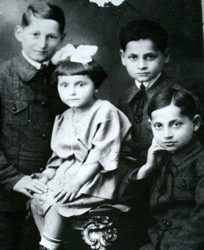
MARKO WITH HIS SISTER AND BROTHERS
THE AMAZING STORY OF MARKO FEINGOLD
When I asked Marko ‘Max-Mordechai’ Feingold, the President of the Jewish Community in Salzburg, about his feelings after lying a “Stolperstein” carrying the name of another Nazi-victim, the old man just put his hands on the left chest, as saying: “my heart stops beating for a moment”. This was the 150th time his heart lacked this very heartbeat since he initiated the project in his hometown in 2005. Not the healthiest thing to do when you are a Holocaust survivor and you approach the age of 99. But Feingold does not care.
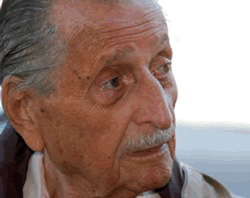
He was born in 1913, as a citizen of the Austro-Hungarian Empire, to Heinrich, a railway worker, and Zilli, a housewife who passed away in 1936. Marko was the third boy after Fritz and Ernst, and the big brother for Rosa. Growing up in Vienna, he concluded a traineeship in commerce and sales. The economic downturn in Austria in 1932 forced Marko and his brother Ernst to leave to Italy to make a living. A terrible coincidence led to his arrest by the Germans who invaded Austria in the beginning of 1938, just when the two brothers came back to prolong their Italian visa. The family was forced to leave Austria for Prague, and then on to Poland. A failed attempt to escape, led Marko and his brother Ernst to a polish prison – and eventually to the labor camp in Auschwitz. Only after the war, Feingold found out that his father was killed in 1939, during the German bombing on Warsaw. The fate of Rosa and Fritz is still unknown.
Q: Did you know what awaits you in Auschwitz?
A: “I was the first Austrian prisoner ever to step foot in Auschwitz. I had the feeling that my end is near, since the rumor was that Jewish prisoners do not survive more than 3 months in this place. I remember when I got there; they beat me and burned my hair with a candle. Auschwitz was back then only under construction. Due to the work and the hard physical conditions, I lost my weight and went down to 30 Kg. After two months I was unsuitable for work, but I was still sent together with Ernst to the labor camp Neuengamme, in northern Germany. We got there during the winter, which was very cold and humid. We were forced to dig with our bare hands a channel between the bricks factory nearby and the city of Hamburg. At this stage, I was so called “gas-able” and was about to be sent to the gas chambers. But the crematorium in the camp wasn’t ready yet. So I was sent with 250 other prisoners on the train to Dachau in the south. Only 75 of us survived the trip that lasted 2 days. This was the last time I saw Ernst. Only in 1950, while I was testifying about Neuengamme, I was asked to pick-up his death certificate. Apparently he died there in 1942, by the time I’ve been already in Buchenwald.”
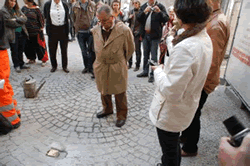
Q: How did you escape the execution in Dachau?
A: “During the journey to the camp I managed to recover somewhat, and got on my feet again. I was positioned there as a translator in a selection hut. Not because I spoke many languages – if somebody asked you something there, you knew automatically that he wanted more food. One day, a Kapo I ran into told me that Jews were not allowed to hold any positions in Dachau. So he sent to me to work in the garden. There, my condition deteriorated further due to the hard work and the clogs we had on. Soon enough my feet got infected and I was housed among the walk-incapable prisoners. Back then, the Nazis had a system to transfer prisoners from camp to camp. Those who collapsed on the way were shot. This way I was transferred to Buchenwald.”
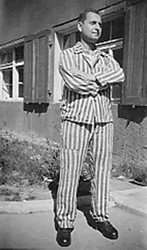
Q: This is the camp where you actually spent the longest time in.
A: “Yes.
I got there in September 1941. We arrived at the train station of Weimar in the evening. From there, we were force
d to march 8 km up the mountain into Buchenwald. Once we reached the camp, we had to walk another 2 km inside. In the beginning I was put to work in the quarry. The Germans needed flat rocks for their roads, so we used to fight among us over ‘the good stones’. Besides that, every little mistake was punished there with death. Afterwards, I joined the ‘Singing Horses of Buchenwald’, a group of prisoners whose job was to sing while they push heavy wagons up the mountain. In August 1942, I started to work as a bricklayer and became pretty good at that. At a certain point I could even leave my post and exchange cigarettes for bread. This gained me a bad reputation among the communists in the camp, although I did it because I was hungry. And when you are hungry, you will do anything. This way, I gained additional 10 kg.”
Q: How did you learn to get along in these difficult situations?
A: “Between the ages 12 and 14, I used to hang around the circus next to my house. There, I got to meet all the workers who many of them were considered to be very dubious. So I learned from them how to become the biggest gangster among all other gangsters.”
Q: What do you remember from the camp’s liberation?
A: “During the American siege on Weimar in April 1945, we slowly noticed that there were less and less S.S soldiers in the camp. In the afternoon of April 11th, we realized that all the guards have escaped. Suddenly a friend of mine called me out ‘because the Americans give out food’. The weird thing was: I was not even hungry.”
Assisting the ‘Bricha’
Just like in every coincidence that has shaped his life, it was again the fate that brought Marko Feingold to Salzburg. He initially intended to return to Vienna, his hometown. But a blockade of the Red Army made him get off the bus in the scenic city. In the years to come, he committed himself to the “Bricha” (in Heb. “Escape”) movement that acted for smuggling Displaced Persons (DP), i.e 250,000 Jewish camp refugees, from the DP-Camps in central Europe, through Italy and then to the Land of Israel.
“I was working in a kitchen that cooked for non-Jewish refugees, receiving 2,000 Schillings per month”, he explains, and adds with a smile: “back then, there were more Jews in Salzburg than inhabitants”. One day, American officials came to him, claiming that the Jews are refusing to eat their meat and demanded vegetables instead. And what firstly started as a simple food exchange, led Feingold to meet Asher ‘Arthur’ Ben Natan, who later became the first Israeli ambassador to Germany, and Dr. Abba Geffen, later to become a prominent Foreign Ministry deputy. The two were in charge on the ‘Bricha’ from Austria and Salzburg. Feingold has turned out to be especially suitable to the mission since he spoke Italian and knew well how to get things. For instance, thanks to a few German army vehicles, which Feingold managed to attain from the Austrian authorities, the ‘Bricha’ succeeded to smuggle 5,000 Jews over the Italian border, in a period of three months.
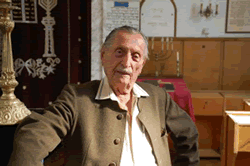
Q: Weren’t the Allies suspicious of what you were doing?
A: “The eastern part of the border was under British control. They had an obvious interest to prevent us from doing our job. The French, on the other hand, closed their eyes. Once, I found a rocky passage through the mountains in an area which the Americans controlled. There, we could already move freely. Many times we had to lead the refugees by foot through the Alps, in terrible cold without any equipment. We used to do it at night, because they were afraid of the heights.”
Q: How many Jews did you help?
A: “Around 100,000 people managed to go to Israel with my help. Most of them don’t even know that it was me.”
Q: Didn’t you want to join them?
A: “My roots here are too deep. I am proud to be a ‘Salzburger’ and I also received many honorary titles. Besides, I don’t think I could have reached the age of 99 anywhere else. Although the thought about it is always here.”
The battle over the memory
The ‘Bricha’ activities ended by 1948, and Marko Feingold had to face, once again, a difficult economic reality. So he opened in Salzburg a fashion shop, and began to tell his story at every opportunity he got. In these years, he was in a big fight with the local Jewish community and the sides barely kept in touch. According to Feingold, the presidium of the community was jealous of him, because he was the most famous Jew in the city. “Only in 1977, when I retired, they realized their mistake and made me to vice president. 2 years later I became the president”, he says.
Ever since, he is (together with his wife Hanna) on a constant mission to commemorate the victims of the Holocaust, and to fight against those who try to deny it.
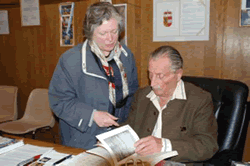
Q: How did you cope with extreme right winged politicians that became in Austria pretty powerful over the years?
A: “Look, in Germany for instance, a man like Haider could never become as big as he was in Austria. Why? Because the most of the population still thinks the way he did. Salzburg is a good example for that. There were always politicians that took advantage of people’s ignorance. It became already a tradition in this country. We could have gone on with our lives a long time ago if the Austrians have said that they knew about the Holocaust, but couldn’t do anything. Instead they say they didn’t know about anything – that’s nonsense! The big problem is that they never really dealt with their past. The first generation didn’t pass-on anything. So the generations after remain ignorant. Sometime I lecture in front of children and it’s like they never heard of WW2.”
Q: Do you have any plans for your 100th year?
A: “I will continue to work with the children about the past, the way I did it in the last 67 years. People here see me as a phenomenon: ‘how can one survive so many camps, and still have the energy to go on?’ I live to tell my stories, and believe me – there are stories which you wouldn’t believe. But there is no one left to tell them, only Feingold!”
